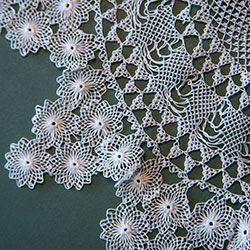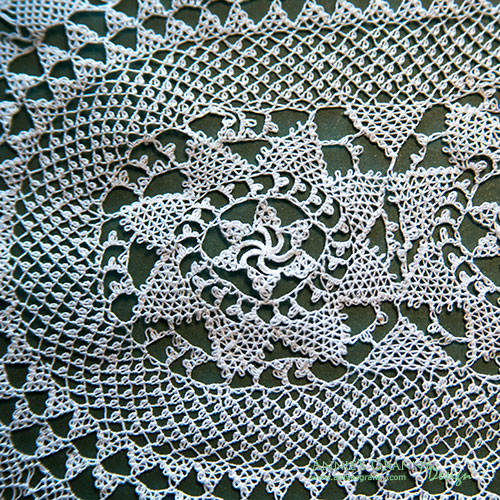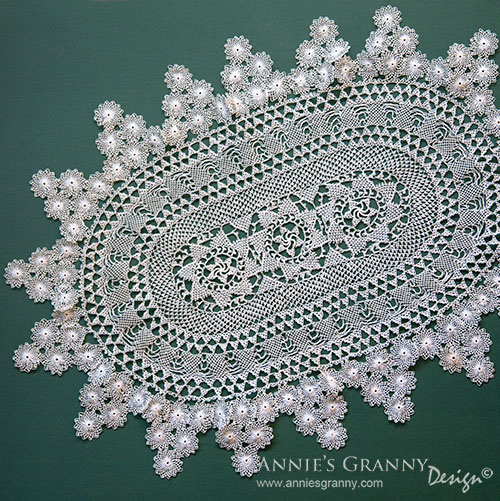Mysteriet löst / Mystery solved
I min förra blogpost berättade jag om den mycket vackra duken som jag hittade på butiken Old Touch på Upplandsgatan i Stockholm. Jag kunde inte bli klok på vad det var för teknik som använts för att göra den. Knypplat, vävt, virkat, eller vad? Eller en blandning av flera?
Till slut hittade jag sidan Lace Fairy, som hade en förteckning över olika tekniker. Efter att ha klickat mig igenom teknik efter teknik kom jag till slut fram till Armenian Bebilla, och Bingo! Där var den!
När jag sedan också hittade boken “The Priscilla Armenian Needlepoint Lace Book” av Nouvart Tashjian från 1923 blev jag helt säker.
In my previous blog post I wrote about the very beautiful doily I found on the shop Old Touch in Stockholm. I could not make out what kind of thread technique was used to make the lace. Bobbin lace, weaving, crochet, tatting, what? Or a mix of several different kinds?
Finally I found the site Lace Fairy, that had a listing over different techniques. I clicked my way through them one by one until I came across Armenian Bebilla, and Bingo! There it was!
When I also found the book “The Priscilla Armenian Needlepoint Lace Book” by Nouvart Tashjian from 1923 I was sure I found it.
Nedan till vänster en uppförstorad detalj från en bild i boken, och till höger en detalj från min duk.
Visst är det samma teknik!
Below to the left an enlarged detail from a picture in the book, and to the right a detail from my doily. Sure it is the same technique!
Enligt boken känner man inte till så mycket om ursprunget till den här tekniken. Tills helt nyligen ska kunskapen om hur man gör sådan här spets ha ansetts som en nödvändig kunskap för varje armenisk flicka. Den var en oumbärlig del i utsmyckningen av hennes brudkista, vars innehåll hon förväntades tillverka helt och hållet själv. Då uppfödning av silkesmaskar förr var en hushållsindustri, kom ofta tråden till dessa spetsar från de silkesmaskar flickorna själva hjälp till att ta hand om. Om man tittar närmare på de bättre typerna av Armenisk spets inser man att det inte var kommersiell efterfrågan utan kärlek till det vackra och rivaliteten i hantverket som gjorde att denna typ av spets fick en sådan hög grad av perfektion. Spetsen tillverkades aldrig för att säljas förrän i slutet av 1800-talet och var därför inte mycket känd i västvärlden. (Utdrag ur boken)
Tekniken kallas även Oya, och är då ofta spets i form av små blommor och andra dekorationer.
Spetsen tillverkas med bara nål och tråd. Det finns en film på YouTube där Florence visar hur hon gör en spetskant på en näsduk. Det finns en annan film som visar en närbesläktat teknik från Turkiet. Helt otroligt vilket arbete som läggs ner på dessa vackra dukar!
According to the book the origin of Armenian needlepoint lace is not definitely known. Until very recent years the making of this lace was regarded as one of the necessary accomplishments of every Armenian girl. It formed an important part in the ornamentation of her trousseau, which she was expected to make entirely herself. The raising of the silkworm was in many places a household industry, so the silk threads used for the lace come from the silkworms which the girl has helped to care for. As one looks at the better types of Armenian lace, one realizes that it was not commercial demand, but love for the beautiful and the rivalry in craftmanship that brought this lace to its high degree of perfection. The lace was never made for sale until the end of the nineteenth century, and therefore was not much know to the Western world. (Book excerpt)
The technique is also called Oya, and is then often used to create small flowers and other embellishments. The lace is made using only a needle and thread. There is a clip on YouTube where Florence is demonstrating how she makes a lace edge on a hankerchief. There is yet another clip showing a similar lace technique from Turkey. Incredible the amount of work that is put into these beautiful lace works!
Se här hur skir och tunn spetsen i min duk är! Det finns inte många bilder på Armenisk spets på nätet att hitta och, om jag får säga det själv, inga som är lika vackra som på den duk jag köpte!
See here how sheer an thin the lace is. There is not than many images of Armenian lace to be found on the net and none, if I may say so, are as beautiful as the one I bought.






Så himla häftigt! Vilket detektivarbete och vad roligt att du fick reda på så mycket. Jag håller med om att duken är fantastiskt vacker. Vilket hantverk!
Interesting. Great find. I’m glad you solved the mystery, well done.